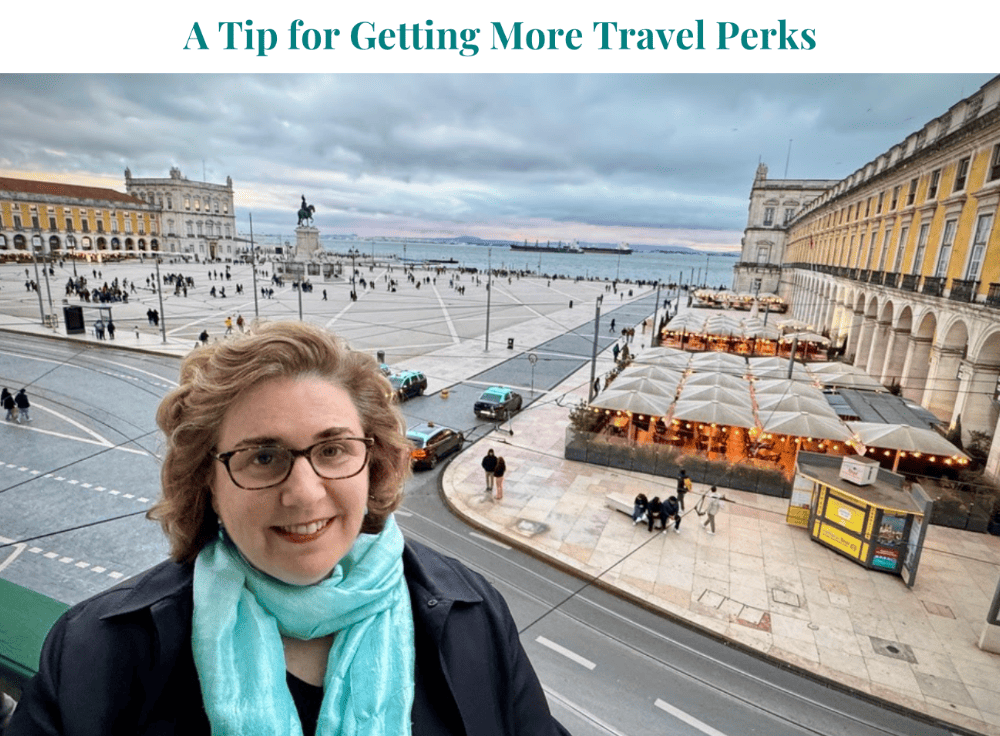Secrets of Southern Spain: Insider’s Guide
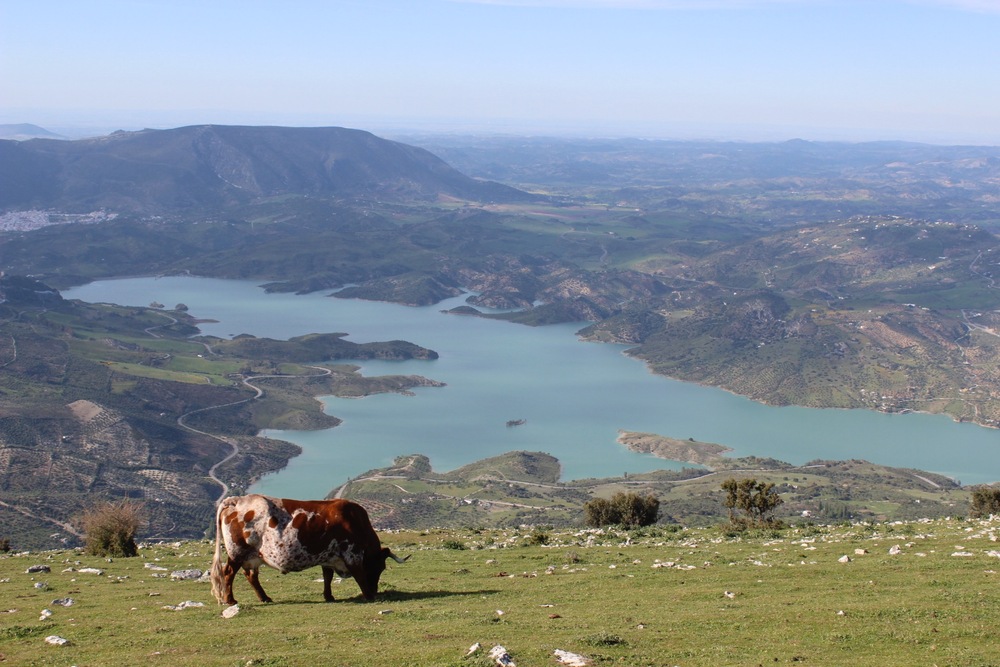 Sierra de Grazalema Natural Park is a bucolic setting in the province of Cádiz. Photo: Genuine Andalusia
Sierra de Grazalema Natural Park is a bucolic setting in the province of Cádiz. Photo: Genuine Andalusia
The insider advice on this page is from one of Wendy’s Trusted Travel Experts for Spain: Iván Ricoy of Genuine Andalusia.
Iván is a born people-person—so much so that he left behind a good engineering job to show travelers the authentic side of Andalusia, his beloved home region in southwestern Spain. He now designs trips throughout southern Spain—from Barcelona, Madrid, Toledo, and Segovia southward, including the Balearic Islands and Gibraltar. On a trip planned by Iván, you’re as likely to share paella at a family gathering as you are to learn the history of the Alhambra. His charisma also opens doors into wineries, pottery workshops, even aristocrats’ palaces. A city walking tour might focus on flamenco and tapas, or on the explosion of modern art that followed the country’s transition to democracy in the 1970s. For a dose of the countryside, he can accompany you to a traditional olive oil mill that’s been in the same family since the 18th century, or on a tranquil bike ride along an old railway path. If he can’t guide you himself, he’ll pair you with local hosts he’s handpicked for their imagination, generosity, and enthusiasm for treating every visitor as a friend.
Where to Stay and Eat
Places like Seville, Granada, and Malaga have become inundated with tourists and no longer have much of a local feel, especially in high season. Rather than staying in one of those cities’ historic centers, Iván encourages travelers to either choose a hotel in a quieter, residential neighborhood that is still walking distance from the iconic sights—Granada’s Seda Club is a great example of 5-star luxury behind an unassuming façade—stay out in the countryside and take day trips into town, or base yourself in a smaller city like Jerez, where the local community still lives, works, and socializes in the old town (see “Hidden Gem,” below).
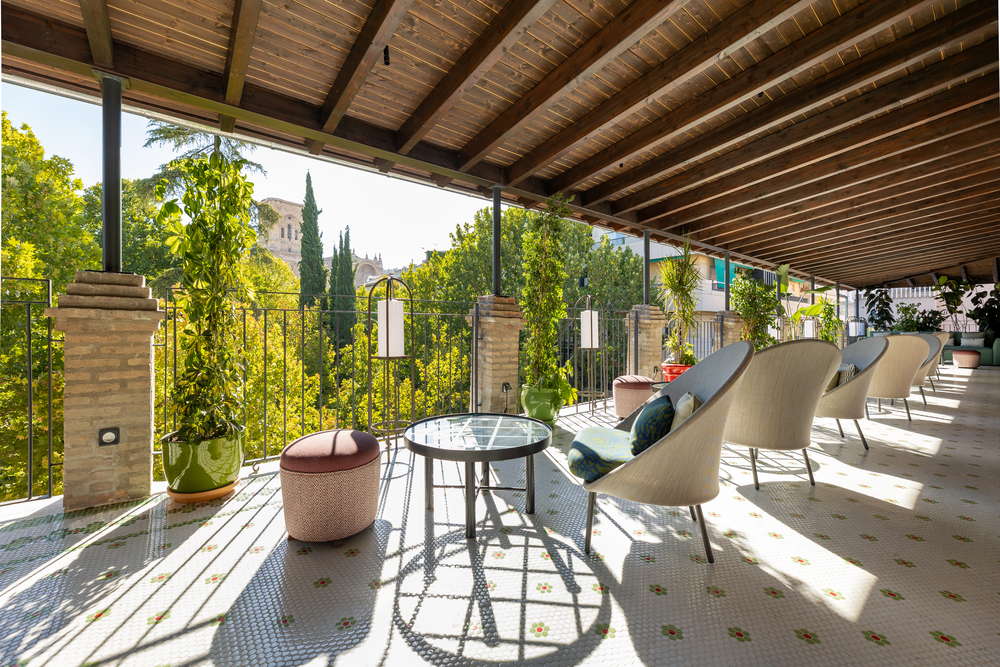
The Seda Club’s rooftop terrace overlooks a leafy plaza in Granada. Photo: Small Luxury Hotels of the World
Best bang-for-your-buck hotel
Casa Palacio María Luisa is a small boutique hotel right in the heart of Jerez’s old town. Here you can feel the soul of Andalusia for half the price, and with half the crowds, that you’d find in the bigger cities—but you’re still only an hour from Seville, and even closer to Cádiz, the beach, and the region’s famous white villages.
Best-value splurge accommodations
The secluded three-bedroom villas with private pools at Hacienda de San Rafael. Situated in the countryside between Seville and Jerez, this estate has lush gardens, carefully curated interiors, and an excellent restaurant that highlights southwestern Andalusia’s culinary traditions. The service here is thoughtful and intuitive. The two villas, each with their own private pool, make an ideal base to combine relaxation in the middle of the Andalusian countryside with urban and coastal explorations.
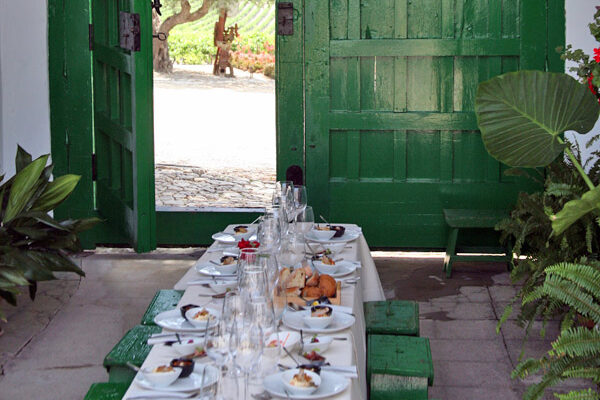
Iván can arrange lunch at a vineyard estate in Jerez de la Frontera. Photo: Genuine Andalusia
Restaurants the locals love
Casa Ricardo in Seville. It is located in the neighborhood of San Lorenzo, which is off the tourist radar but close to the city center. Casa Ricardo has probably the most delicious croquetas in all of Andalusia; these delicious fried dumplings—comfort food devised by families on a tight budget after the Civil War—are crispy on the outside but have a creamy interior of bechamel, sometimes flavored with ham, mushroom, or shrimp.
Casa el Pisto in Córdoba. No visit to Córdoba is complete without eating a tapa of salmorejo, and this rustic tavern is the place to order it. A variation on gazpacho, salmorejo is traditional to this part of Andalusia, where farmers looking for something heartier added day-old bread and more olive oil to the classic recipe; Spaniards drink gazpacho, but they eat salmorejo with a spoon. Enjoy yours among the locals at a high table near Casa el Pisto’s bar, surrounded by posters of Córdoba’s famous bullfighters.
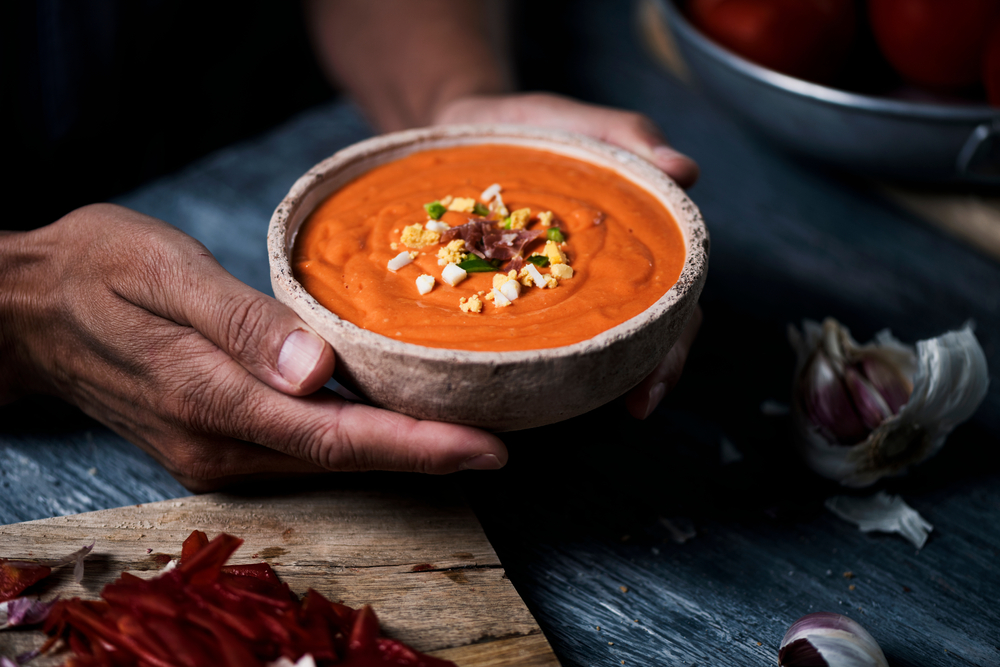
Salmorejo is a thicker, heartier version of gazpacho; try it in Córdoba. Photo: Shutterstock
Taberna La Tana in Granada. The owner of this casual wine and tapas bar sources his produce from local organic farms, and the artichokes, tomatoes, and green asparagus are of particularly excellent quality; any dish prepared with them will be a winner.
Dish to try
Tortillitas de camarones (baby shrimp fritters). This is a typical dish from the province of Cádiz that can be found anywhere along its coast, made with shrimp harvested in local estuaries. The best fritters are like lace, so thin that you can see through them, and crunchy—never mushy. You’re sure to get an excellent version at Casa Balbino, in the town of Sanlúcar de Barrameda.
Meal worth the splurge
A red tuna feast at El Campero in Barbate. Southernmost continental Spain has some of the best wild bluefin red tuna in the world; El Campero offers a tasting menu that highlights different preparations and parts of the tuna. Want to make it even better? Go for the wine flight—they really know their pairings here.
What to See and Do
Don’t miss
Immersing yourself in the southern Spanish lifestyle. Trends that are just now becoming popular in other cultures—finding work-life balance, downsizing, walking, healthy eating—have been the way of life in southern Spain for decades. When you’re visiting a shepherd with their flock or taking a cooking class in a humble home kitchen, ask your host about what brings them happiness. Iván has seen such exchanges prove transformative to many travelers, with lasting effects on their daily routine at home. This could be the most important souvenir you bring back from your trip to southern Spain!
Don’t bother
Seeing northern Morocco on a day trip. This requires spending a large chunk of your day traveling, so you end up with just a few hours in Morocco. It’s a big country with lots to see, so save it for its own trip.
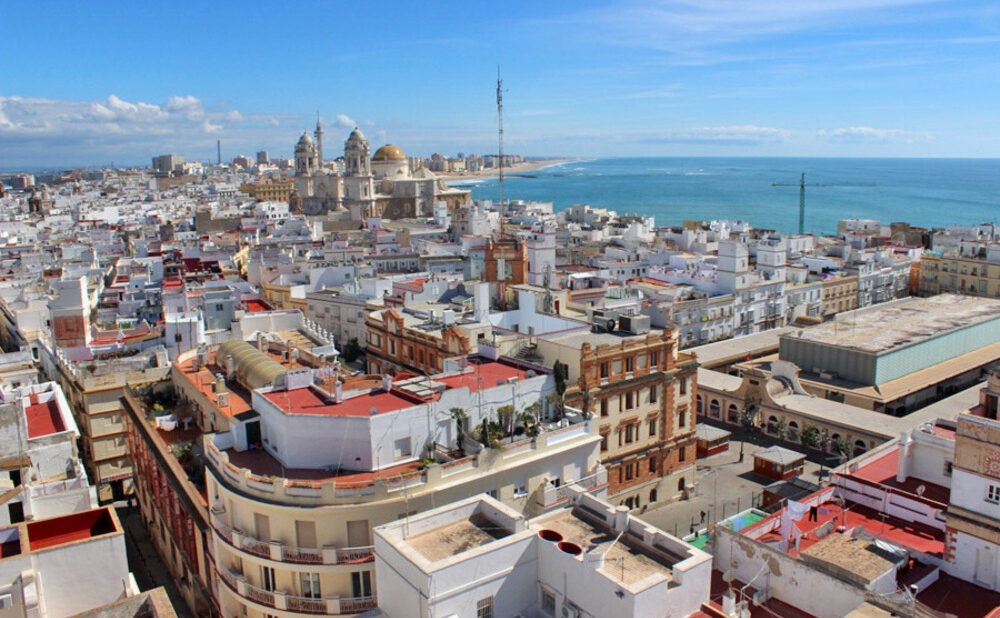
On the island-city of Cádiz, you’re never far from the ocean. Photo: Genuine Andalusia
Most Underrated Place
Cádiz. This city—which is is actually an island off the Atlantic coast—is the colonial gem of southern Spain. It held a monopoly on trade with the New World in the 18th century, becoming a wealthy, cosmopolitan, multicultural, bourgeois, and liberal trading hub. Cádiz has colorful colonial residences from that period, many squares with cafés and gardens, coastal parks, and a great food scene. It is also probably the most pedestrian-friendly city in southern Spain.
Most Overrated Place
Marbella and the Costa del Sol. This area has a high density of large resorts, a busy highway running close to the coast, and darker sand than you’ll find elsewhere. If you want to spend time at the beach, go instead to Costa de la Luz, Costa Tropical, or Costa de Almería.
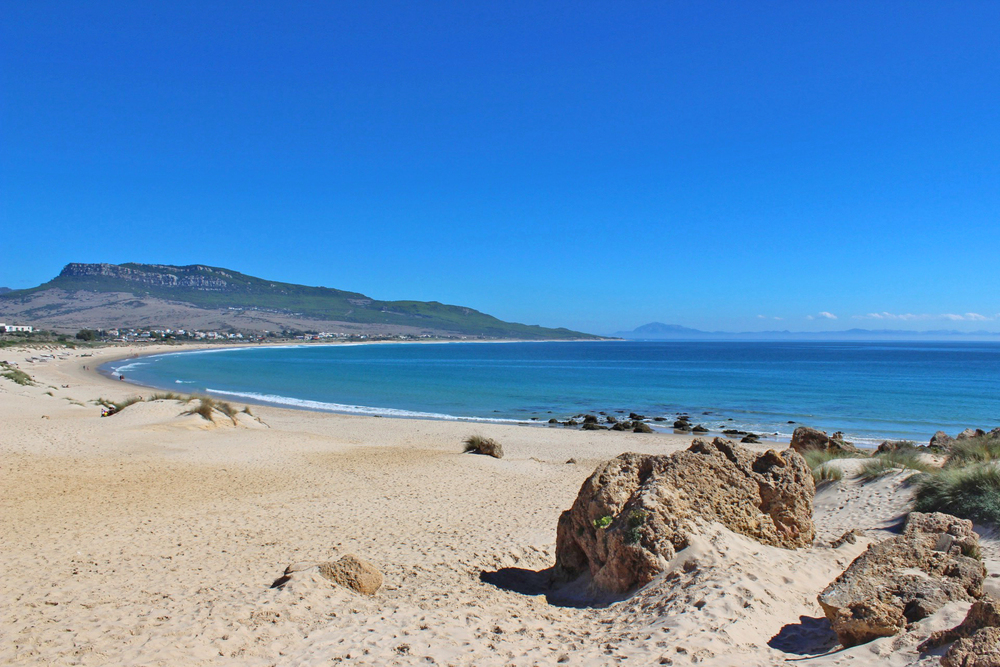
Bolonia Beach on the Costa de la Luz: Since the beach faces southwest, the sun hits it all day long and then sets over the water. Photo: Genuine Andalusia
Hidden Gem
Jerez de la Frontera. Eclipsed to the west by Seville and to the east by the Costa del Sol, Jerez is a mid-sized city that is seldom visited by travelers but where the true Andalusian essence is untouched: It has a unique wine scene (sherry can only be produced in Jerez and the immediate surroundings), it is the cradle of Flamenco music, and it is where Spanish horses are bred and trained. Jerez also has many excellent restaurants where you can simply drop in for a meal rather than having to book months in advance. With introductions from Iván, you can meet the city’s artisanal food producers, cobblers, guitar makers, and even aristocrats (see “Bragging rights,” below).

Sherry aging at a bodega in Jerez de la Frontera. Photo: Genuine Andalusia
Bragging rights
Spend the day on a private sherry vineyard, overlooking the rolling hills of the Sherry Triangle, where the same family has been living for generations. The property is completely off the grid, relying instead on rainwater and a small generator. The wife can tell you—through your guide’s translations—about her early years living there, before she moved to town for school. While she cooks a delicious lunch, her husband will lead you through a tasting of their sherries, which they make only for family and friends (most of their grapes they sell to a cooperative).
Iván also knows many Andalusian aristocrats; these eccentric folks exude confidence from their long lineage, but they are also genuinely warm and delight in sharing a bottle of wine and showing you around their family property.
Best Time to Go
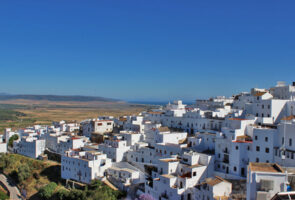
November has beautiful post-summer weather and fewer crowds. A more local vibe also returns in November, and hotel prices drop significantly.
Worst Time to Go
August has very hot weather inland and loads of Spanish tourists on the coast.
Biggest Rookie Mistake
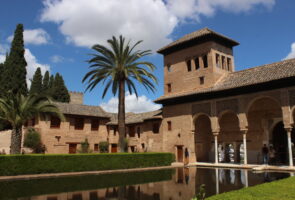
Not securing your Alhambra entry well in advance. An entire day’s worth of tickets often sell out months ahead, especially when cruise ships are docked in Malaga. Reserve your spot through the Alhambra’s official website.
Can't-Miss Photo Op
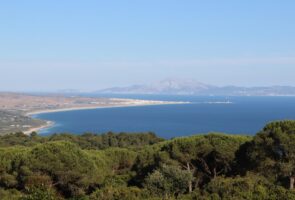
There is a little-known hiking trail that climbs through pine forest and then runs along the rocky ridge atop the Sierras de San Bartolomé in the Natural Park of the Straits of Gibraltar. Stand here and you can see the Mediterranean Sea to your left, the Atlantic Ocean to your right, and Africa straight ahead.
Cheap Thrill
The Seville Museum of Fine Arts houses one of the best art collections in Spain, with remarkable works by Spanish master painters such as Goya and Velázquez; the entrance fee is under $2.
Prime Picnic Spot
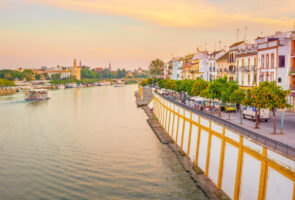
In Seville, grab some snacks and wine, stroll down to the Guadalquivir River, and choose a spot on the bank between the Golden Tower and the Triana Bridge. From here you can enjoy the view across the water to the beautiful neighborhood of Triana.
Word of Warning
Don’t expect authentic paella in southern Spain. Though travelers often think of the dish as generically Spanish, traditionally it was prepared only in the eastern part of the country and is not local to Andalusia.
The Souvenir
A good bottle of sherry. There are a few producers with limited-edition sherries that can only be found in the Sherry Triangle. Ask for recommendations at a local shop like Vinos y Licores La Estrella in Jerez.
How to Spend a Lazy Sunday
Stroll one of the arts-and-crafts markets in Seville, which are only held on Sundays and feature individually made paintings, ceramics, etchings, and more. Since Seville is home to an excellent fine-arts school, you may snag a piece by an emerging artist soon to make a name for themselves. There is a market right below the Triana Bridge, and another one just outside the Museum of Fine Arts.






